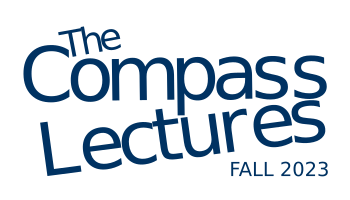
The Compass Lecture Series is a collection of research talks given by Berkeley researchers in the physical sciences. These talks are unique in that they are designed for an undergraduate audience. The goal of the lecture series is to introduce undergrads to as many areas of research as possible using language and physics concepts they can understand. The lectures take place on the Fridays listed below at 3:10 PM (a.k.a. 3PM Berkeley time) in 325 Physics South (unless otherwise noted).
The Fall 2023 Lectures:
Lecture 1 (Friday, September 15th, 2023):
What the Existence of Humans teaches us about the expansion of the universe and its final fate
Lecture 2 (Friday, September 22nd, 2023):
Lecture 3 (Friday, September 29th, 2023):
2D materials: the great physics sandbox
Lecture 4 (Friday, October 6th, 2023):
Modeling the Large-Scale Structure of the Universe with Deep Learning
Lecture 5 (Friday, October 13th, 2023):
Geochronology: The rock clocks of Earth history
Lecture 6 (Friday, October 27th, 2023):
Testing relativity in the lab with ultra precise atomic clocks
Lecture 7 (Friday, November 3rd, 2023):
Black Holes, Quantum Information, and Emergent Spacetime
Lecture 8 (Friday, November 17th, 2023):
Lecture 9 (Friday, December 1st, 2023):
It’s Not Easy Being Green: Using Data and Modeling to Unveil an Imposter Aurora
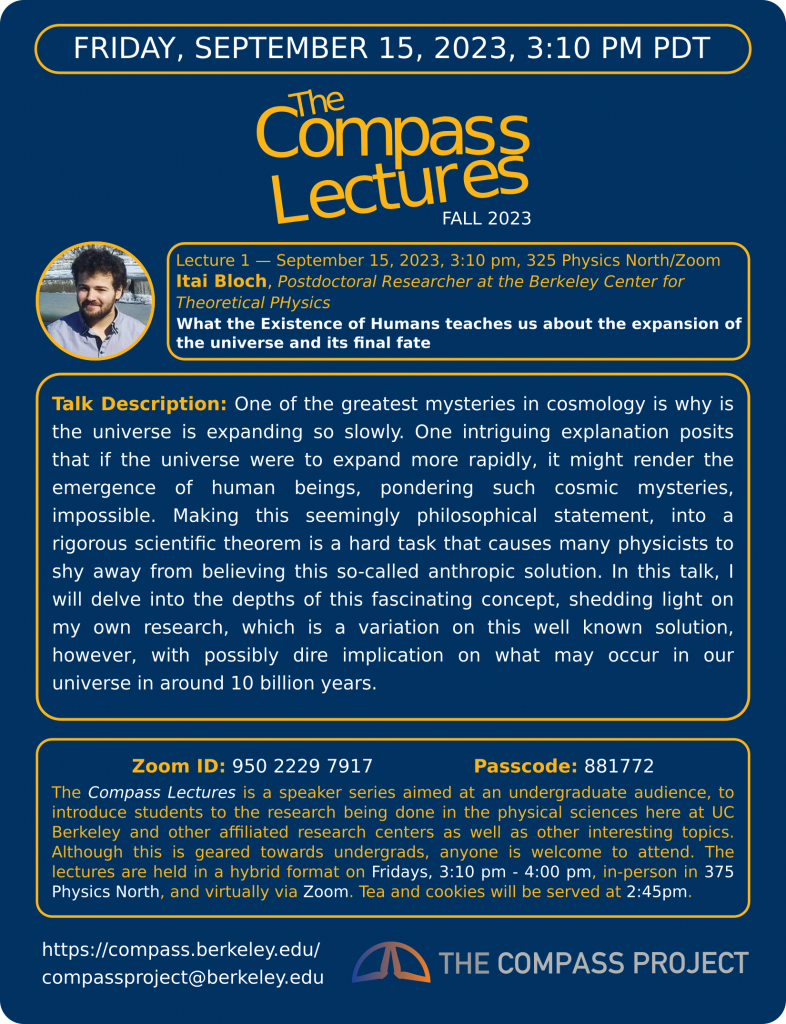
What the Existence of Humans teaches us about the expansion of the universe and its final fate
Itai Bloch, Postdoctoral Researcher at the Berkeley Center for Theoretical Physics
Date & Time: Friday, September 15th, 2023, 3:00 pm – 4:00 pm
Location: 325 Physics South and Zoom
Talk Description: One of the greatest mysteries in cosmology is why is the universe is expanding so slowly. One intriguing explanation posits that if the universe were to expand more rapidly, it might render the emergence of human beings, pondering such cosmic mysteries, impossible. Making this seemingly philosophical statement, into a rigorous scientific theorem is a hard task that causes many physicists to shy away from believing this so-called anthropic solution. In this talk, I will delve into the depths of this fascinating concept, shedding light on my own research, which is a variation on this well known solution, however, with possibly dire implication on what may occur in our universe in around 10 billion years.
Recording: https://youtu.be/v_hHg1mLigo
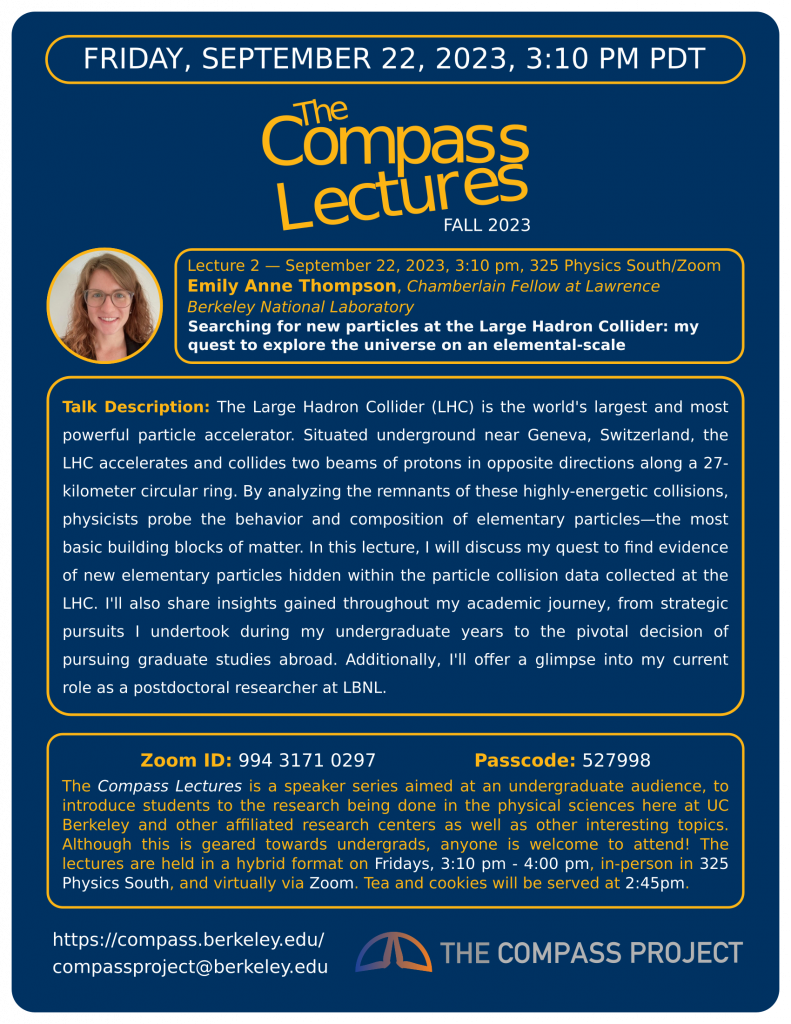
What’s going on down there? An experimental exploration of intergranular dynamics in deep Earth using high-pressure and high-temperature synchrotron X-ray diffraction techniques
Emily Anne Thompson, Chamberlain Fellow at Lawrence Berkeley National Laboratory
Date & Time: Friday, September 22nd, 2023, 3:00pm – 4:00pm
Location: 325 Physics South and Zoom
Talk Description: The Large Hadron Collider (LHC) is the world’s largest and most powerful particle accelerator. Situated underground near Geneva, Switzerland, the LHC accelerates and collides two beams of protons in opposite directions along a 27-kilometer circular ring. By analyzing the remnants of these highly-energetic collisions, physicists probe the behavior and composition of elementary particles—the most basic building blocks of matter. In this lecture, I will discuss my quest to find evidence of new elementary particles hidden within the particle collision data collected at the LHC. I’ll also share insights gained throughout my academic journey, from strategic pursuits I undertook during my undergraduate years to the pivotal decision of pursuing graduate studies abroad. Additionally, I’ll offer a glimpse into my current role as a postdoctoral researcher at LBNL.
Recording: https://youtu.be/XpM_v8hBz6E
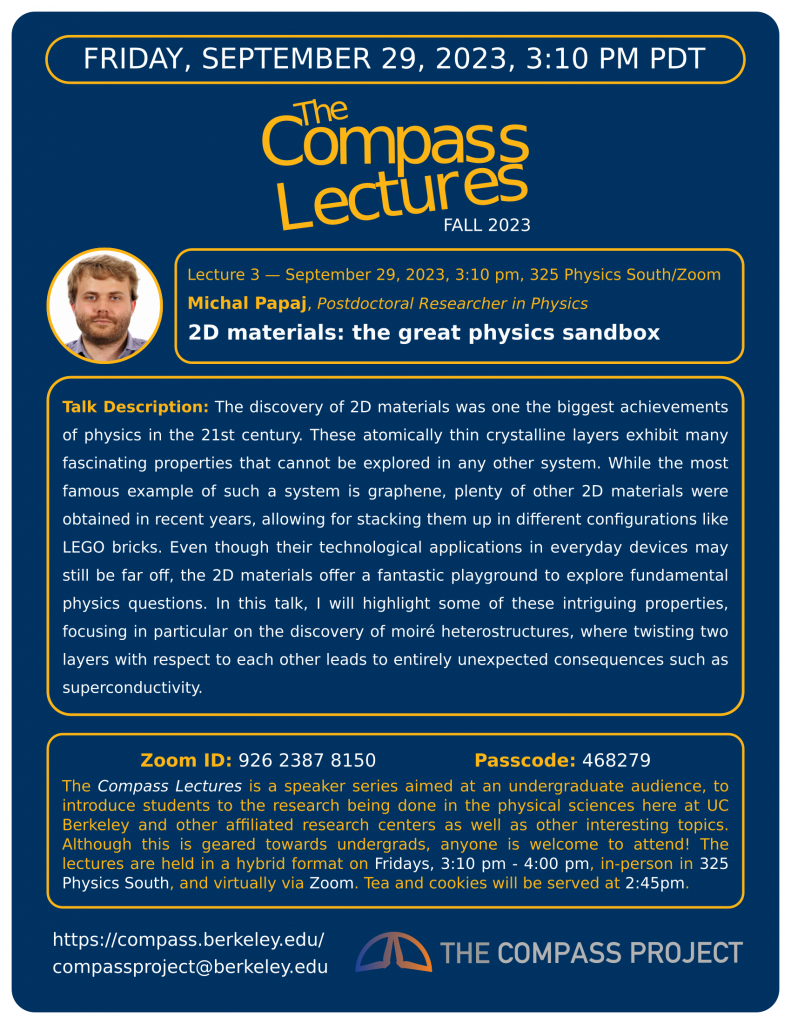
2D materials: the great physics sandbox
Michal Papaj, Postdoctoral Researcher in Physics
Date & Time: Friday, September 29th, 2023, 3:00pm – 4:00pm
Location: 325 Physics South and Zoom
Talk Description: Nuclear physics as a field is interested in answering a variety of questions. The ones that drew me to this field are in the more philosophical realm: Where did we come from? What are we made of? How were we created? My research focuses in using the basic principles of the subatomic world to better understand the answers to these questions.
(No recording available)
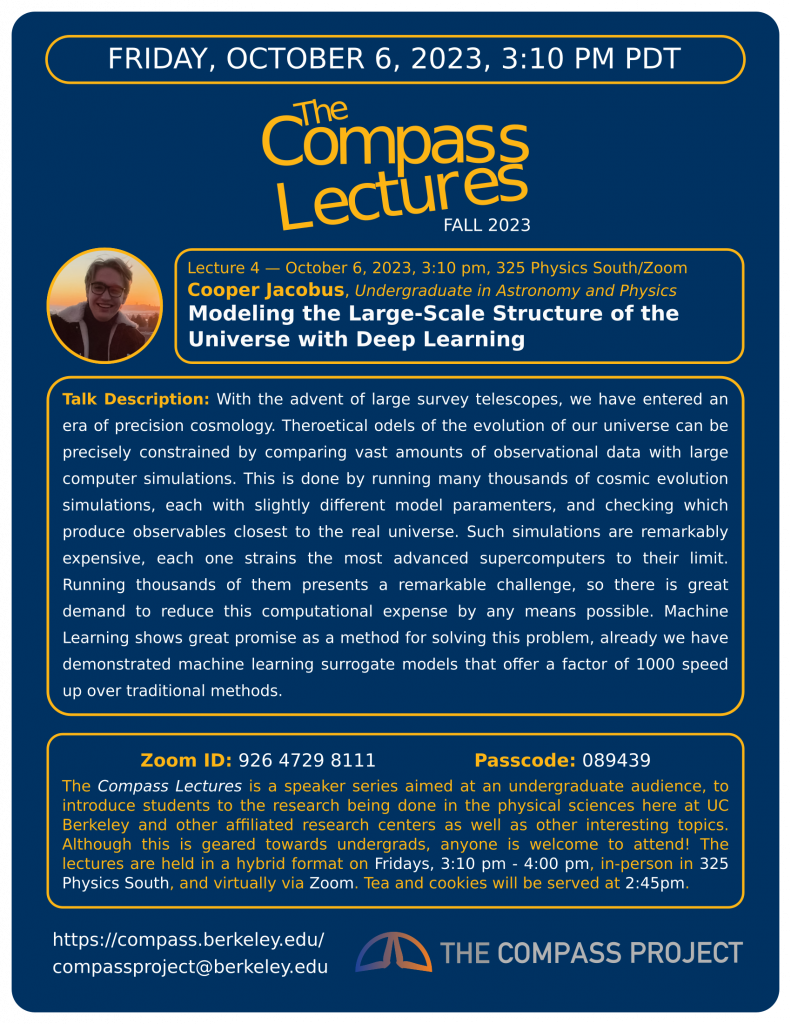
Modeling the Large-Scale Structure of the Universe with Deep Learning
Cooper Jacobus, Undergraduate in Astronomy and Physics
Date & Time: Friday, October 6th, 2023, 3:00pm – 4:00pm
Location: 325 Physics South and Zoom
Talk Description: With the advent of large survey telescopes, we have entered an era of precision cosmology. Theroetical odels of the evolution of our universe can be precisely constrained by comparing vast amounts of observational data with large computer simulations. This is done by running many thousands of cosmic evolution simulations, each with slightly different model paramenters, and checking which produce observables closest to the real universe. Such simulations are remarkably expensive, each one strains the most advanced supercomputers to their limit. Running thousands of them presents a remarkable challenge, so there is great demand to reduce this computational expense by any means possible. Machine Learning shows great promise as a method for solving this problem, already we have demonstrated machine learning surrogate models that offer a factor of 1000 speed up over traditional methods.
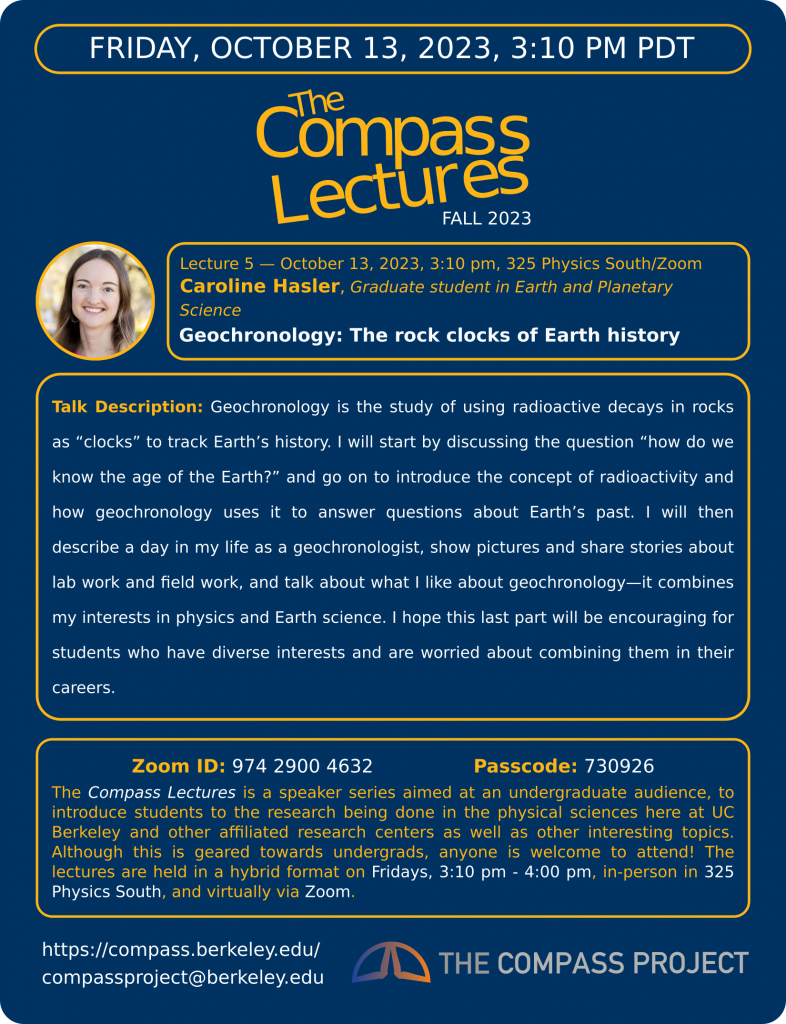
Geochronology: The rock clocks of Earth history
Caroline Hasler, Graduate Student in Earth and Planetary Science
Date & Time: Friday, October 13th, 2023, 3:00pm – 4:00pm
Location: 325 Physics South and Zoom
Talk Description: Geochronology is the study of using radioactive decays in rocks as “clocks” to track Earth’s history. I will start by discussing the question “how do we know the age of the Earth?” and go on to introduce the concept of radioactivity and how geochronology uses it to answer questions about Earth’s past. I will then describe a day in my life as a geochronologist, show pictures and share stories about lab work and field work, and talk about what I like about geochronology—it combines my interests in physics and Earth science. I hope this last part will be encouraging for students who have diverse interests and are worried about combining them in their careers.
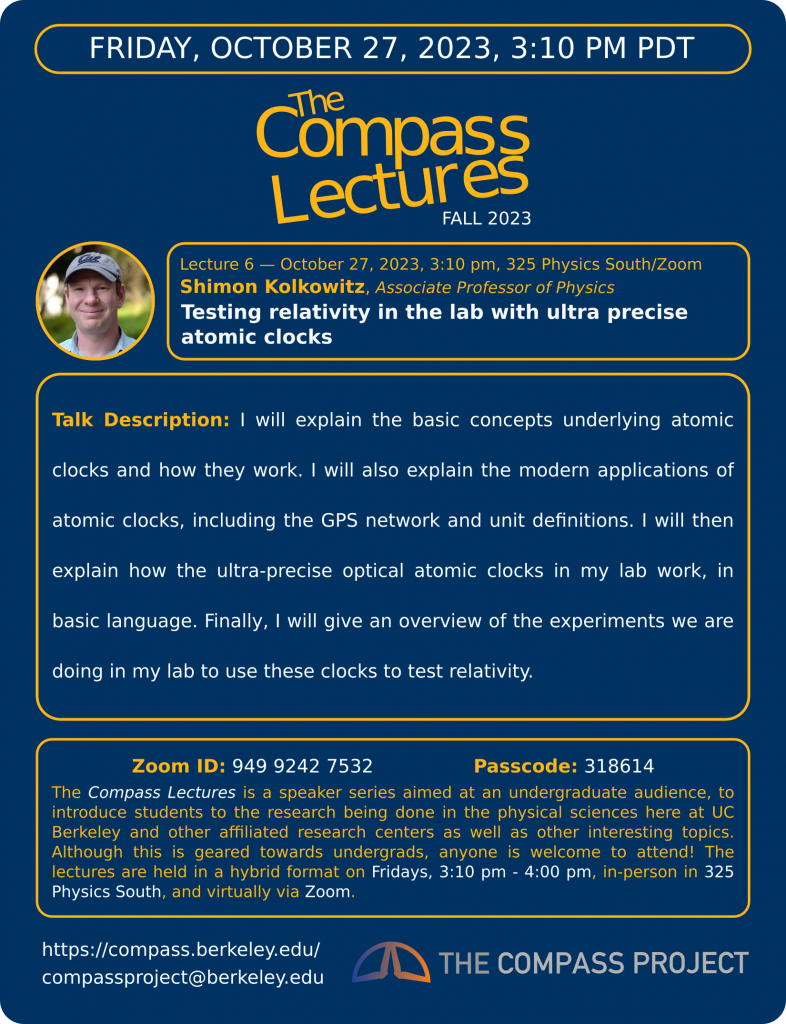
Testing relativity in the lab with ultra precise atomic clocks
Shimon Kolkowitz, Associate Professor of Physics
Date & Time: Friday, October 27th, 2023, 3:00pm – 4:00pm
Location: 325 Physics South and Zoom
Talk Description: I will explain the basic concepts underlying atomic clocks and how they work. I will also explain the modern applications of atomic clocks, including the GPS network and unit definitions. I will then explain how the ultra-precise optical atomic clocks in my lab work, in basic language. Finally, I will give an overview of the experiments we are doing in my lab to use these clocks to test relativity.
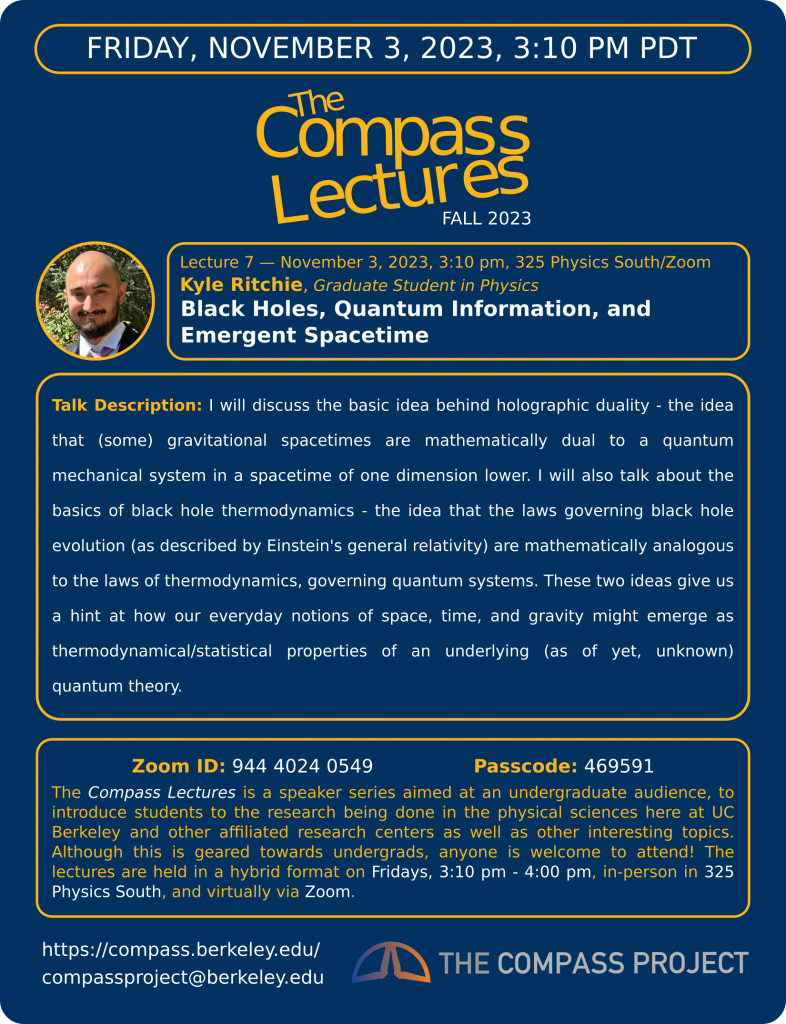
Black Holes, Quantum Information, and Emergent Spacetime
Kyle Ritchie, Graduate Student in Physics
Date & Time: Friday, November 3rd, 2023, 3:00pm – 4:00pm
Location: 325 Physics South and Zoom
Talk Description:
I will discuss the basic idea behind holographic duality – the idea that (some) gravitational spacetimes are mathematically dual to a quantum mechanical system in a spacetime of one dimension lower. I will also talk about the basics of black hole thermodynamics – the idea that the laws governing black hole evolution (as described by Einstein’s general relativity) are mathematically analogous to the laws of thermodynamics, governing quantum systems. These two ideas give us a hint at how our everyday notions of space, time, and gravity might emerge as thermodynamic/statistical properties of an underlying (as of yet, unknown) quantum theory.
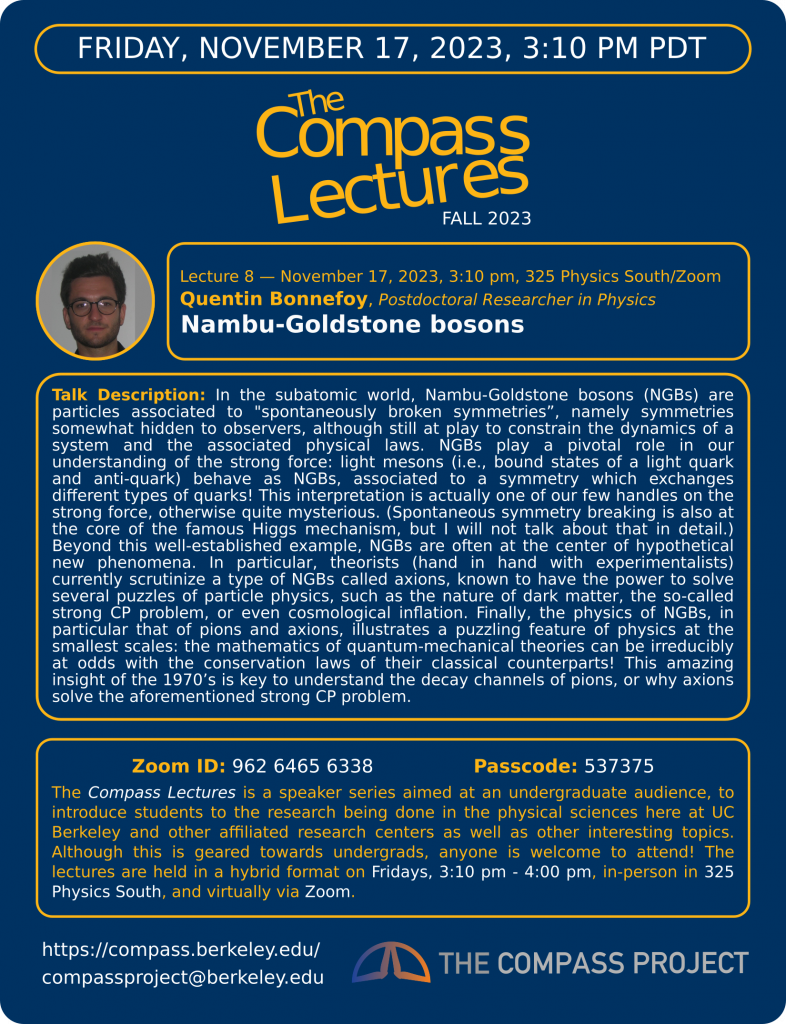
Nambu-Goldstone bosons
Quentin Bonnefoy, Postdoctoral Researcher in Physics
Date & Time: Friday, November 17th, 2023, 3:00pm – 4:00pm
Location: 325 Physics South and Zoom
Talk Description: In the subatomic world, Nambu-Goldstone bosons (NGBs) are particles associated to “spontaneously broken symmetries”, namely symmetries somewhat hidden to observers, although still at play to constrain the dynamics of a system and the associated physical laws. NGBs play a pivotal role in our understanding of the strong force: light mesons (i.e., bound states of a light quark and anti-quark) behave as NGBs, associated to a symmetry which exchanges different types of quarks! This interpretation is actually one of our few handles on the strong force, otherwise quite mysterious. (Spontaneous symmetry breaking is also at the core of the famous Higgs mechanism, but I will not talk about that in detail.) Beyond this well-established example, NGBs are often at the center of hypothetical new phenomena. In particular, theorists (hand in hand with experimentalists) currently scrutinize a type of NGBs called axions, known to have the power to solve several puzzles of particle physics, such as the nature of dark matter, the so-called strong CP problem, or even cosmological inflation. Finally, the physics of NGBs, in particular that of pions and axions, illustrates a puzzling feature of physics at the smallest scales: the mathematics of quantum-mechanical theories can be irreducibly at odds with the conservation laws of their classical counterparts! This amazing insight of the 1970’s is key to understand the decay channels of pions, or why axions solve the aforementioned strong CP problem.
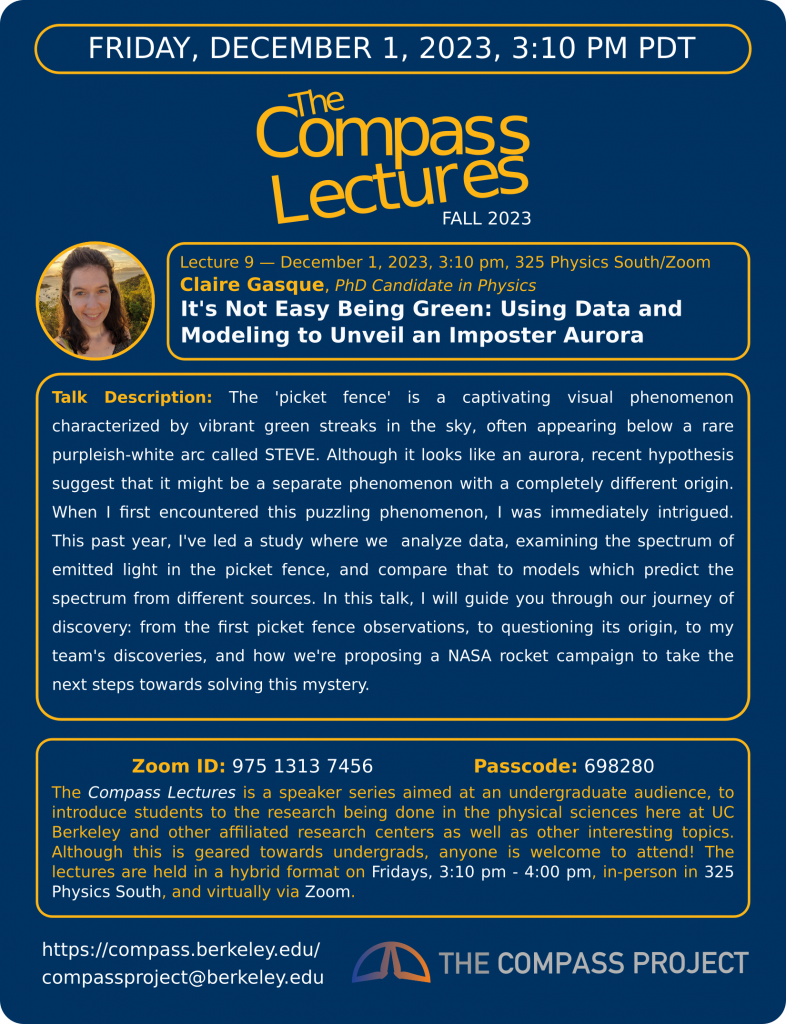
It’s Not Easy Being Green: Using Data and Modeling to Unveil an Imposter Aurora
Claire Gasque, PhD Candidate in Physics
Date & Time: Friday, December 1st, 2023, 3:00pm – 4:00pm
Location: 325 Physics South and Zoom
Talk Description: The ‘picket fence’ is a captivating visual phenomenon characterized by vibrant green streaks in the sky, often appearing below a rare purpleish-white arc called STEVE. Although it looks like an aurora, recent hypothesis suggest that it might be a separate phenomenon with a completely different origin. When I first encountered this puzzling phenomenon, I was immediately intrigued. This past year, I’ve led a study where we analyze data, examining the spectrum of emitted light in the picket fence, and compare that to models which predict the spectrum from different sources. In this talk, I will guide you through our journey of discovery: from the first picket fence observations, to questioning its origin, to my team’s discoveries, and how we’re proposing a NASA rocket campaign to take the next steps towards solving this mystery.